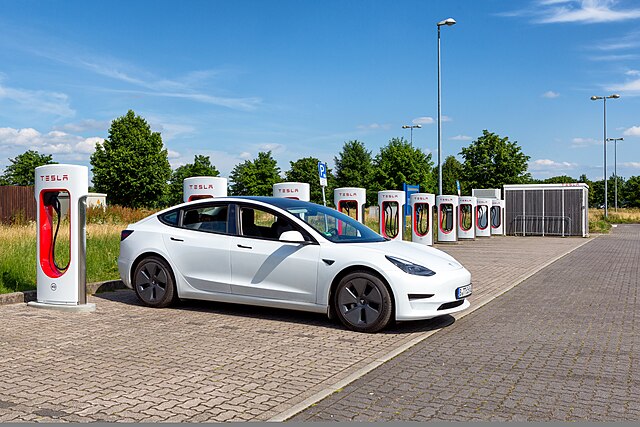One of the executive orders President Trump signed on Monday calls for ending federal subsidies to and preferences for electric vehicles. With numerous media reports that EV sales were already tanking, some think that Trump’s order will kill the market for electric vehicles. It won’t, but it will shift things around.
A Tesla Model S at a Supercharger station in Germany. Photo by Avda.
Curiously, Trump’s order is supported by Elon Musk. He claims he simply opposes all subsidies, but some think that he hopes an end to subsidies will benefit Tesla by discouraging other automakers from developing new electric vehicles. But there is a hidden cost to this order that could severely impact Tesla’s bottom line.
Trump’s order does not immediately eliminate any of the subsidies, some of which would require an act of Congress, but it directs his administration to work towards that goal. The most obvious subsidy is the $7,500 tax credit for buyers of electric cars. This subsidy is not as substantial as it could be since roughly half of American families don’t earn enough income to pay $7,500 in federal taxes, and thus can’t take full advantage of this tax credit.
There’s a hidden subsidy, however, known as regulatory credits in which various state and national governments require all automakers to sell a certain percentage of zero-emission vehicles. Those who don’t sell enough can buy credits from those that sell a surplus. Since Tesla sells only electric vehicles, it can sell regulatory credits to companies such as Chrysler that don’t sell enough.
In recent years, Tesla has earned close to $1.8 billion a year, or more than 40 percent of its profits, from selling regulatory credits. This revenue represents a subsidy from buyers of petroleum-fueled vehicles to buyers of electric vehicles and is a major reason why Tesla has been able to sell electric vehicles for less money its rivals among the traditional car companies.
A decade or so ago, Ford was skeptical of electric vehicles, but now it trails only Tesla in the number of such vehicles it makes each year. It seems likely that Ford entered the EV market on such a large scale mainly so it could avoid paying credits to Tesla. That bet didn’t turn out well for Ford.
In the United States, the regulatory credits market was created by California and 13 other states that had required manufacturers to make electric vehicles. Trump’s order revokes the ability of states to impose different emissions requirements from the rest of the nation, thus essentially killing regulatory credits. Some European countries are also ending their EV subsidies and regulations.
Prior to Trump’s order, the EV market wasn’t dying, but it wasn’t doing great either. Tesla’s worldwide sales dropped by just 1 percent in 2024, but its sales in the U.S. dropped by 23 percent. However, Tesla’s decline was probably due to the growth of EV sales by other companies, notably Ford.
As a share of the U.S. car market, pure EVs grew from 2 percent in 2019 to around 8 percent in 2024 while hybrids grew from around 2 percent in 2019 to 13 percent in 2024. More than one out of five automobiles sold in the U.S. in 2024 were one form of electric or another.
While sales may be up, companies such as Ford and General Motors were unable to make a profit on the EVs, particularly the pure electric vehicles, that they were selling. Inventories grew and manufacturers were forced to slash prices to sell them. Unlike Tesla, Ford and GM still sold enough petroleum-powered vehicles that they probably couldn’t earn any regulatory credits from other manufacturers, so they were unable to compete with Tesla’s prices.
Along with range anxiety, the high cost of EVs is often cited as a major reason why people aren’t buying more of them. Just how much more do EVs cost? Since some manufacturers make the same model of car in gasoline, hybrid, plug-in hybrid, and/or full electric versions, we can compare the prices of those cars.
The Hyundai Tucson and Kia Sportage, for example, are made in pure gasoline, hybrid, and plug-in hybrid versions. According to Edmunds, the hybrids are listed at about $5,000 more than pure gas, while the plug-ins add another $6,000 to the price. The plug-in Chrysler Pacifica is about $11,000 more than the pure gas version. The hybrid Toyota RAV4 is about $2,000 more than the regular, while plug-in adds $14,000 more to the price. The hybrid Ford Escape is $5,000 more than the regular while a plug-in adds another $4,000.
I’ve always thought that plug-in hybrids provided the best balance between electric and pure gas vehicles, and I’m not the only one to wonder why so few are made. The answer appears to be cost, since they seem to add at least as much to the price of a hybrid vehicle as the hybrid adds to a pure gas vehicle.
Going full EV is at least as expensive as a plug-in hybrid. A full-electric Ford Lightning is about $8,000 more than a similarly equipped Ford F-150. Similarly, a Mach-E is about $8,000 more than a similar Ford Mustang. Subaru’s Solterra is about $10,000 more than a similarly equipped Crosstrek, which is about the same size. Volvo’s full electric cars cost about $12,000 to $20,000 more than mild hybrid versions of the same vehicle. (A mild hybrid has a gasoline engine that generates electricity for electric motors but no batteries to store energy from regenerative braking.) Volvo is the only manufacturer I can find that makes the same model in pure electric and plug-in versions, and the pure electric is priced at $7,000 more.
Of course, manufacturer’s list prices don’t necessarily reflect manufacturing costs. Tesla makes about $3,000 in regulatory credits for each car it sells. If making an electric vehicle saves another manufacturer $3,000 or more in such credits, it would be willing to sell that vehicle for that much less than a gas vehicle.
In addition, most manufacturers only sell their EVs with premium trim levels. Another dirty secret of the auto industry is that manufacturers make much bigger profits on their premium cars than their base level cars. A particular model of car may have a base price of $28,000 while the premium versions sell for $40,000 or more, while the actual cost of making the premium car may only be a couple thousand more than the base car. Good luck in actually finding a base-level car at an auto dealer near you. What this means for EVs is that, if they only sell premium-level versions of electric vehicles, manufacturers have that much more profit they can play with to make the car — but they are less likely to do so if electric car mandates disappear.
If Trump’s order survives legal challenges, the end of regulatory credits will completely disrupt the market. Back in 2023, Ford announced that it was moving from pure EVs to more hybrids and plug-in hybrids, and an end to regulatory credits will likely see GM and other traditional manufacturers make a similar shift. Chrysler, for example, is “pausing” its Ram electric truck.
Such a shift will leave pure EV makers like Tesla and Rivian with fewer competitors, but it will also eliminate the regulatory credits those companies get, thus forcing them to raise their prices. While Tesla says that it hasn’t been planning on getting regulatory credits forever, I suspect that pure EVs will lose ground to various forms of hybrids in the foreseeable future.









“Along with range anxiety, the high cost of EVs is often cited as a major reason why people aren’t buying more of them”
Two good reasons. Another is initial quality, which is quite poor compared to ICE vehicles. EV software is buggy and glitchy. Many consumers prefer knobs and buttons on the instrument panel, but EVs come with huge touchscreens, which are difficult to navigate and use, especially while driving.
Tumalo Joe,
Unfortunately, almost all cars are now coming with touch screens, most of which are difficult to navigate while driving, so that is not an indictment of EVs.
No. In five years California went from “EV cars are the future” to FOR GODS SAKE DONT PLUG THEM IN you’ll melt the grid. Average income for EV car owners is 100,000 dollars. it was never about the environment it was about subsidizing rich people’s play toys, from an embezzling crypto billionaires who played musical chairs with his money.
BMW’ largest factory is in USA, South Carolina, virtually all it’s car manufacturing jobs left; in favor of EV’s, Net Zero is killing German industry.
https://pbs.twimg.com/media/Gh7mRUZXcAA0Ho5?format=jpg&name=medium
The point is, electric cars storage medium is 80x less dense than fossil fuels, meaning 80x material demand per unit of energy storage is needed. Thou the electric motor is More “Efficient” than a gas engine, no efficient means generate sufficient power to run an automotive fleet. I did/presented calculations over and over again on various articles in past.
For EV’s to takeover you need 3x the nations powerplants to charge em on a 24 hour daily and a 30 fold Grid expansion to support 600 volt or greater high speed charging in 30 minutes. Gasoline, diesel, aviation fuel, marine oil fuel, etc works to about 96 Exajoules or 26.6 Trillion kilowatt hours a year. That’s 288.86 Petajoules per day (80.238 Billion kilowatt hours). Daily US electric consumption is 10.4 Billion kilowatt hours; Though the venerable electric motor is 2-3 times as efficient as an engine, you still need 5x more electricity than current to replace the transportation energy network.
Battery Electric Vehicles will make sense only when there is a large and reliable source of “carbon free” electric power. And that is available only from hydro and nuclear sources.
Of course, we may eventually figure out that all this carbon-based “global warming” is just green fiction.
Germany took away BEV subsidies – consumer and producer – for 2024 and BEV market share dropped from 13.5% vs. 2023’s 18.4%. Hybrids took up most of that slack although pure ICE market share increased a bit too.
The more electric range the bigger the battery. The bigger the battery the more expensive the car. That’s why BEV’s are more expensive than plug-in hybrids are more expensive than standard hybrids are more expensive than ICE-only.
Sure, car makers make a bigger margin on premium trim level cars but that’s been true since the first car rolled of the assembly line. It’s also true for most other consumer goods including food and shampoo.
I agree with you that hybrids seem to provide the best balance between ICE and electric vehicles. However, I’ve spoken to two automotive engineers who claim much of the cost difference is due to the complexity of fitting two engine types in one vehicle. I’ve also read (sorry I don’t recall where) that a substantial portion of hybrid owners rarely charge their cars. I don’t know if they bought their cars for virtue signaling purposes or if they’re just too lazy to set up a charging system. As someone who used to drive cars in a northern environment where plugging in your engine heater at night was necessary in order for your car to start in the morning, I find that hard to understand.